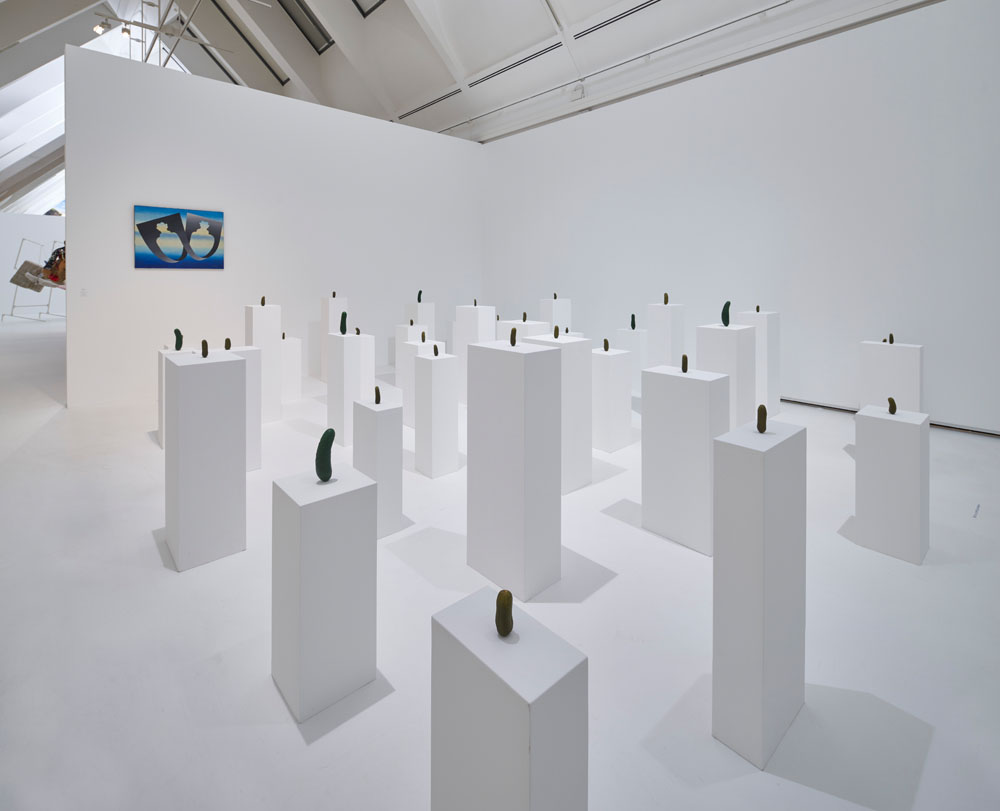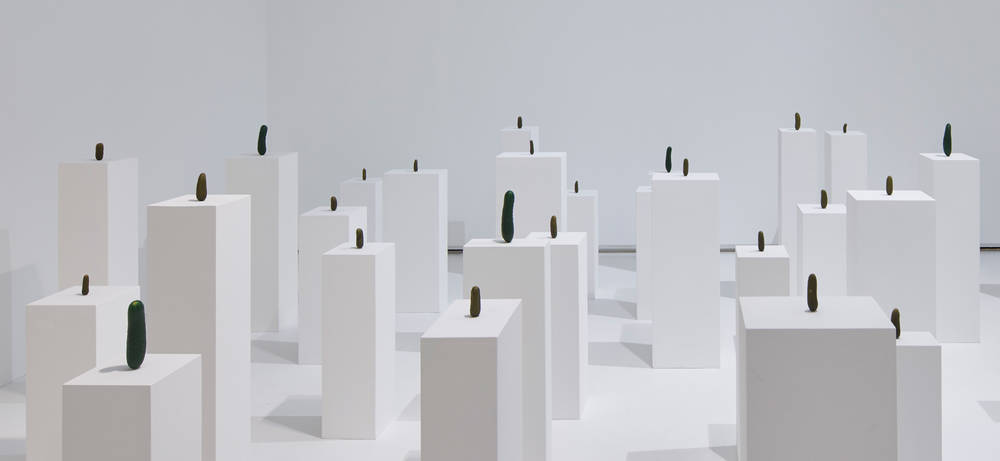No cold collation would be complete without pickled cucumbers: on Erwin Wurm’s work “Selbstporträt als Essiggurkerl”.
In 2008, there was a debate in the EU Parliament on abolishing “Regulation no. 1677/88/EEC laying down quality standards for cucumbers”. The cucumber bend regulation symbolized what was considered excessive bureaucracy in the Union.
The same year Austrian artist Erwin Wurm produced his sculptural installation “Selbstporträt als Essiggurkerl” (Self-portrait as a pickled cucumber). Was this a coincidence or a strategy typical of the Austrian? Born in 1954, he has been teaching Sculpture and Multimedia at Vienna’s Universität für Angewandte Kunst since 2002 and with his “One Minute Sculptures” not only inspired the rock band Red Hot Chili Peppers but simultaneously achieved an international breakthrough. In this participative artwork all you have to do is follow the artist’s sketched-out instructions for one minute, thus becoming a component part in a temporary sculpture yourself. The work was presented to visitors to Frankfurt’s Städel Museum two years ago.
These “One Minute Sculptures” follow in an artistic tradition evidenced by the work of such artists as Piero Manzoni, Gilbert & George and Franz Erhardt Walther which has elevated the active participation of the viewer and the human body to the sphere of art.
Wurm initially favored a classic definition of sculpture as “work on a volume”. But then – very much in the tradition of Beuys – he remarked that everybody is a sculptor: “
Indeed it could be said that gaining and losing weight is also, to a certain extent, work on a volume. And so one could come to the conclusion that gaining and losing weight is also sculpture.”

Erwin Wurm, One Minute Sculpture, Image via publicdelivery.org
The problem with broadening the meaning of the term “sculpture” in this way, particularly to include three-dimensional self-portraits of this kind, has already been described by Jacques Derrida, who wrote that “if what people call a self-portrait is dependent on people actually calling it a self-portrait the act of naming should in fact allow me to call anything a self-portrait […]”
“Selbstporträt als Essiggurkerl” – the title is the only thing that guarantees that this work of art has the quality of a self-portrait, even though at first glance it might look like a “piece of witty sculptural entertainment”.
Indeed, Wurm’s work unleashes a string of associations, associations that, it must be said, are different in every case. Pickled cucumbers, something that forms an integral part of South German cuisine, a meal that a Swabian would refer to as a “Vesper”, a Bavarian as a “Brotzeit” and an Austrian as a “Jause”. And no cold cuts would be complete without pickled cucumbers! Humor, after all, can be acidic and as Wurm says “humor is a weapon”.
As superstition has it, when a woman suddenly has a craving for pickled cucumbers it’s an unmistakable sign that she is pregnant. But what actually is a pickled cucumber? In German a “pickled cucumber” is used to denote a used car that is little more than a wreck, or the kind of large nose sported by some men, or the kind of guy who tends to make a hash of things, for instance soccer players who disappoint their fans at a game.

Wurm’s self-portrait is an installation with a slightly phallic quality to it, consisting of 36 differently-sized bases on each of which a very different and unique, deceptively genuine-looking cucumber is mounted: Six cucumbers and 30 pickled cucumbers made of acrylic and with acrylic paint applied painstakingly to them. I don’t think there was ever a more beautiful homage to cucumbers. And, as Helmut Friedel explains, “Wurm once designed a (pickled) cucumber for an award ceremony – a small or large, slightly obscene symbol of a rather ridiculous, perhaps even idiotic victory. But even there, the lasting impression is one of parody rather than provocation and what starts out as an obvious affront ends up, at the end of the day, as an award.”
Asked about his work, the artist says: “Rather like potatoes, cucumbers are an age-old non-shape. There are millions of different cucumbers. No cucumber is the same as the next, rather like people. That appeals me a great deal.”
Do self-portraits reveal their artists’ characters and self-images? If so, what we have here is a testimony to a skeptic artist, one who uses wit and irony and sometimes even ridicule as artistic strategies. An artist who has one felicitous gift: humor.
Incidentally, since 2009 cucumbers in the EU have again been allowed to grow as they like, however bent or straight that might be.


How Hip Hop sings about its dead
Death plays a large part in Hip Hop. The tragic early passing of legends such as Biggie Smalls and Tupac, not to mention rising superstars like...

5 questions for Mary Messhausen and proddy produzentin
With the performance "Thonk piece: Hungry for Stains", drag queens Mary Messhausen and proddy produzentin will open the exhibition COSIMA VON BONIN....

HIP HOP IS BLACK CULTURE – NOT THE OTHER WAY AROUND
Hip hop’s 50th birthday is an occasion for us to listen to some old records and mixed tapes and to look back at the most important hip hop films of...

Now at the SCHIRN:COSIMA VON BONIN
The SCHIRN is showing a unique presentation of new and well-known works by COSIMA VON BONIN until June 9.